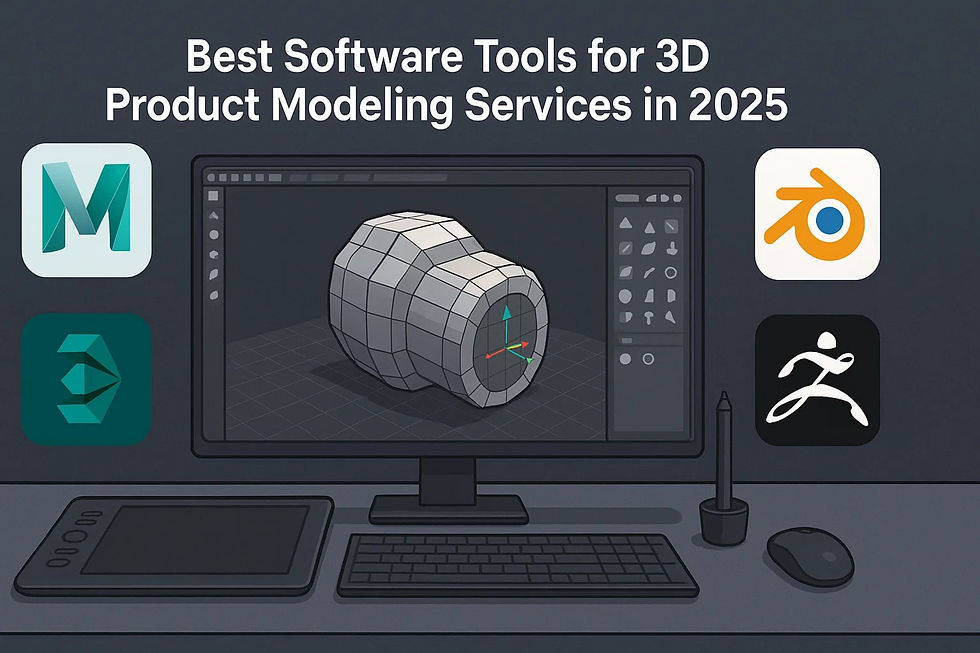Behind the Scenes: The Process of Making a 3D Model Augmented Reality
- Hemant vizent
- Jun 21
- 4 min read

Process of Making a 3D Model Augmented Reality
In a world driven by immersive technology, 3D modeling for augmented reality (AR) has emerged as a crucial process bridging the gap between the digital and physical realms. From furniture showrooms to interactive learning apps, AR has transformed industries with its ability to project realistic digital objects into real-world settings. But what powers this futuristic experience? At the heart of every successful AR application is a meticulously crafted 3D model.
This blog takes you behind the scenes of AR 3D Modeling—breaking down the process, tools, and best practices that define high-quality 3D modeling services tailored for AR, VR, and 3D printing applications.
Understanding 3D Modeling for Augmented Reality
Augmented Reality relies heavily on spatial accuracy and photorealism. Unlike traditional 3D assets, 3D Model Augmented Reality projects must be lightweight for mobile devices yet detailed enough to feel immersive. These models must respond dynamically to lighting, scale correctly in real environments, and integrate seamlessly with AR engines like ARKit, ARCore, or Unity.
To achieve this balance, creators turn to specialized 3D product modeling services that are fluent in both technical requirements and artistic execution.
Step 1: Conceptualization and Research
Every AR Product Visualization project begins with understanding the client’s vision. Whether it's a digital twin of a product, a piece of furniture, or an architectural prototype, the process starts with references—photos, blueprints, or physical measurements.
Here, 3D Modeling Services gather data to define:
Dimensions and proportions
Intended usage (e.g., mobile AR, VR headset, or 3D print)
Level of detail (LOD) required
Surface material and texture types
This step ensures that the 3D model will not only look accurate but will also perform well across platforms.
Step 2: Blocking and Base Mesh Creation
The modeling process kicks off in 3D software like Blender, Maya, or 3ds Max. The first milestone is creating the base mesh—a simplified, low-poly representation of the object’s shape. For AR 3D Modeling, this step is particularly important because AR apps require real-time rendering. The base mesh serves as the skeleton of the object and is refined over several iterations. Artists use reference images to align proportions and ensure accurate scale.
Step 3: Detailing and Topology Optimization
After blocking, artists begin to add finer details. These might include ridges, curves, vents, or stitching, depending on the object. High-detail models are often sculpted in tools like ZBrush, then retopologized to create a lighter version suitable for AR and VR.
For Virtual Reality 3D Modeling, balance is key. While VR allows slightly higher detail than AR, models must still maintain performance standards to prevent motion sickness or lag.
Step 4: UV Mapping and Texturing
For AR Product Visualization, this step is essential to bring realism to digital objects.
Artists unwrap the 3D model’s surface into a 2D layout and then paint textures using tools like Substance Painter or Photoshop. Textures simulate materials such as:
Metal
Wood
Plastic
Glass
Fabric
For example, a furniture company using 3D furniture design services might request different fabric swatches or wood grain textures for a single AR chair model.
Step 5: Lighting and Baking
Although real-time AR uses the environment's lighting, artists still bake certain lighting effects—like ambient occlusion and normal maps—into the textures. This technique enhances realism without burdening the app with complex light calculations.
3D product rendering services often bake these effects into the model so they appear consistent across lighting conditions, making the object feel more "anchored" in reality.
Step 6: Rigging and Animation (If Needed)
Some AR applications require interactivity. For example, a 3D shoe model might rotate when tapped or expand to show internal components. To enable this, rigging—a digital skeleton—is added to the model. Animators then define movements or interactions.
This step is also vital for 3D Modeling for 3D Printing if the design involves articulated parts, like hinges or movable joints.
Step 7: Exporting and Optimization for Platforms
.glTF/.GLB (preferred for WebAR)
.USDZ (iOS ARKit)
.FBX (Unity/Unreal)
Each platform has its own poly count and material limitations. 3D Model Maker for 3D Printer might also convert files into STL or OBJ formats for slicing software like Cura or PrusaSlicer.
Professionals in 3D Modeling Services ensure that every asset is optimized for its final destination—whether it's a hologram, VR showroom, or physical print.
Step 8: Integration and Testing
After export, the model is integrated into an AR environment via engines like Unity, Vuforia, or WebAR platforms. Here, developers test:
Tracking accuracy
Scale consistency
Responsiveness to lighting
User interactivity
Feedback from this phase often loops back to the modeler for final tweaks. The collaboration between 3D product modeling services and AR developers ensures the final product is both functional and visually stunning.
Real-World Applications
1. Retail and E-commerce
Brands are using 3D Model Augmented Reality to let customers visualize products in their space, be it sofas, makeup, or appliances.
2. Architecture and Real Estate
AR 3D Modeling is transforming floor plans into walkthroughs, enabling buyers to explore spaces before they’re built.
3. Education and Healthcare
Interactive anatomical models created through VR 3D Modeling are improving training for medical students and surgeons alike.
4. Manufacturing and Custom Design
With 3D Modeling for 3D Printing, companies can rapidly prototype and visualize components in AR before finalizing production.
Final Thoughts
The world of 3D modeling for augmented reality is both art and science. Behind every interactive AR app lies hours of modeling, sculpting, mapping, and testing. Whether you’re a startup launching a new product or an enterprise looking to digitize a catalog, investing in high-quality 3D product modeling services can be the competitive edge you need. With the right partners, your digital vision can become an interactive reality—one polygon at a time.





Comments